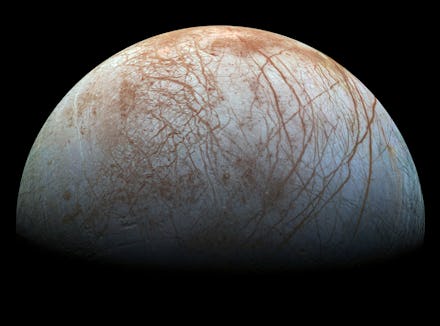NASA's Top Scientists Have Concluded the Year We'll Encounter Alien Life

Chief scientists at NASA said Tuesday we'll have conclusive evidence of alien life by, at latest, 2045.
"I think we're going to have strong indications of life beyond Earth within a decade, and I think we're going to have definitive evidence within 20 to 30 years," NASA chief scientist Ellen Stofan said during a webcast panel discussion that focused on the agency's hunt for habitable zones — planets, moons and asteroids containing water — beyond Earth.
"We know where to look. We know how to look," Stofan said. "In most cases we have the technology, and we're on a path to implementing it. And so I think we're definitely on the road."
While some may be quick to write this kind of proclamation off as one zany scientist's ramblings, Stofan isn't the space agency outlier. No one asked her to pump the brakes on alien talk. A former astronaut of five missions to space and NASA's Science Mission Directorate, John Grunsfeld, said, "I think we're one generation in our solar system, whether it's on an icy moon or on Mars, and one generation [away] on a planet around a nearby star."
Age of discovery: The panel discussion comes at the heels of a string of the most promising discoveries in the search for alien life we've ever seen: A warm water ocean was discovered on Saturn's moon Enceladus in March. In January, evidence of another liquid ocean was found on the dwarf planet Ceres. In August 2014, Stofan was part of a panel that discussed Europa, an icy moon of Jupiter that has its own ocean, as a good bet for alien life.
"All the ingredients are there to make us think Europa is the next place to go," she said at the time, according to Space.com.
These aren't even places beyond our solar system. We're talking alien life that could live in planets we've seen made of styrofoam in fourth-grade science fairs — and moons we can see from our backyards.
Challenges remain: The trick is going to be identifying actual alien life. NASA may luck out and find aliens that just hang out on the surface and move around and leave footprints. Or, they could all be dead, which means having to search for evidence without any sense of what we're even looking for.
"I go out and break open rocks and look for fossils," Stofan, who is also a field geologist, said during the talk. "Those are hard to find. So I have a bias that it's eventually going to take humans ... actually out there looking for that good evidence of life that we can bring back to Earth for all the scientists to argue about."
Regardless of what goes into finding the signs of life, NASA is hopeful — even passionately optimistic. We're getting one step closer to answering the question NASA communications officer Dwayne Brown asked at the beginning of the panel, and the planet has been asking for damn near ever: "Where did we come from? Where are we going? Are we alone?"
Within a few decades, we'll know for sure.